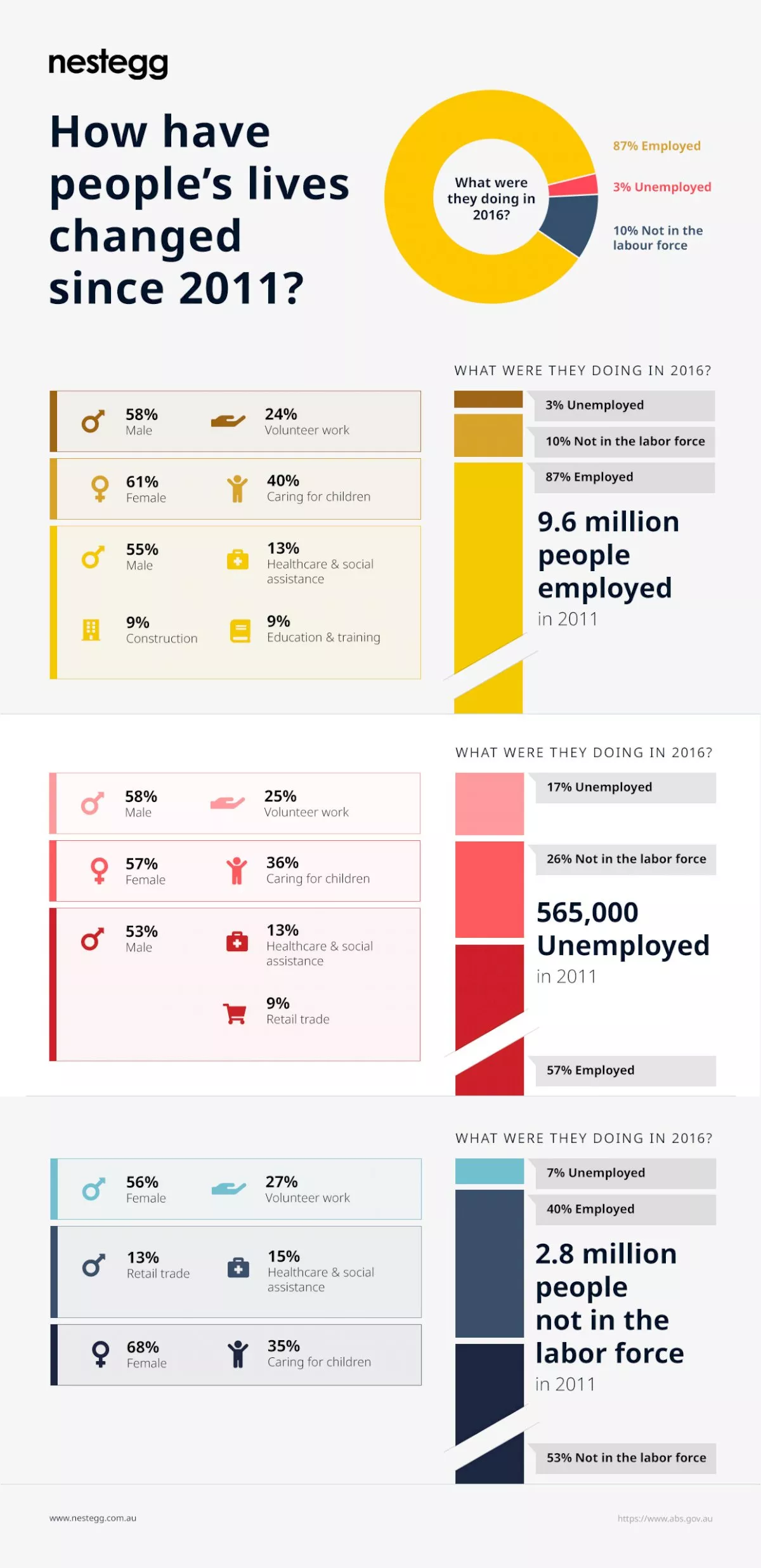Resources
How have people’s lives changed since 2011?
INFOGRAPHIC: The Australian Bureau of Statistics conducts the Census of Population and Housing every five years – with the first to third waves done in 2006, 2011 and 2016, respectively.

How have people’s lives changed since 2011?
INFOGRAPHIC: The Australian Bureau of Statistics conducts the Census of Population and Housing every five years – with the first to third waves done in 2006, 2011 and 2016, respectively.


The ABS performed a comparison of employment data between 2011 and 2016 (waves 2 and 3) in Australians’ journeys through life: Stories from the Australian Census Longitudinal Dataset (ACLD).
The comparison revealed that only a small percentage of the employed population aged 15 to 59 in 2011 changed their employment status. However, a large portion of the unemployed population in 2011 joined the labour force by 2016.
What employed people in 2011 did in 2016
According to the report, there were 9.6 million Aussies who were employed in 2011 but only about 8.4 million or 87 per cent remained employed in 2016. Among them, 58 per cent are male and 61 per cent are female.
However, these numbers aren’t necessarily a cause for alarm because only 3 per cent are unemployed, while 10 per cent are no longer in the labour force by 2016.
Among the employed, 13 per cent are in healthcare and social assistance, 9 per cent are in construction and 9 per cent in education and training.
More than half of the unemployed (about 58 per cent) are males, and 24 per cent of the unemployed male population opted to do volunteer work for an organisation in the past year.
Meanwhile, 61 per cent of the unemployed females have chosen to focus on caring for their children.
What unemployed people in 2011 did in 2016
Positive changes were seen in the 565,000 unemployed people in 2011 – with only 17 per cent still unemployed and 26 per cent not in the labour force in 2016.
Among the unemployed, 58 per cent are males, with 25 per cent of this number choosing to do volunteer work.
On the other hand, 57 per cent of females who are not in the labour force opted to step out to care for their children.
Fifty-seven per cent of the unemployed population, on the other hand, gained employment by 2016. Among them, 13 per cent are in healthcare and social assistance work, while 9 per cent entered the retail trade.
What people outside the labour force in 2011 did in 2016
In 2011, about 2.8 million people were not in the labour force. A little over half of them – at 53 per cent – retained this status in 2016.
Among those who did not participate in the labour force, 68 per cent are women, of whom 35 per cent chose to care for their children.
On the other hand, 40 per cent of non-participants were employed in 2016, with 13 per cent in the retail trade and 15 per cent in healthcare and social assistance.
Of the 7 per cent who were unemployed in 2016, 56 per cent are females and 44 per cent males. Among them, 27 per cent chose to do volunteer work.
About the author

About the author


Cracking the facts
Investment property or stocks?
Should you invest in stocks or investment property to build your wealth? In this video, we explore both options and see which one can help you better achieve your financial goals. ...Read more

Cracking the facts
What is a financial adviser?
If you’re struggling with managing your money, planning your retirement or looking to build your wealth with the proper investment strategy, you may be in need of solid financial advice from an expe...Read more

Cracking the facts
Labour costs in Australia
INFOGRAPHIC: The Australian Bureau of Statistics’ Major Labour Costs survey has revealed that a large proportion of labour costs incurred by employers were paid towards employee earnings and superan...Read more

Cracking the facts
What does the job sector look like in Australia?
[INFOGRAPHIC] The Australian job sector saw a boost in FY 2016-17, with the majority of regions reporting an increase in jobs compared with the previous financial year. ...Read more

Cracking the facts
Australians’ weekly spending based on life stage
According to ABS data, Australian households spent $1,425 per week*. ...Read more

Cracking the facts
Sector jobs across Australia
INFOGRAPHIC: Recent data from the Australian Bureau of Statistics (ABS) revealed that the number of job vacancies in Australia increased in the February 2019 quarter. ...Read more

Cracking the facts
Where are Australians going on holiday?
INFOGRAPHIC: Australians are among the most well-traveled people in the world, with many of us taking a number of short-term trips each year. ...Read more

Cracking the facts
What is the highest-earning postcode in each state/territory?
[INFOGRAPHIC] The ATO has released the annual Taxation Statistics report for the financial year 2016-17. ...Read more

Cracking the facts
Investment property or stocks?
Should you invest in stocks or investment property to build your wealth? In this video, we explore both options and see which one can help you better achieve your financial goals. ...Read more

Cracking the facts
What is a financial adviser?
If you’re struggling with managing your money, planning your retirement or looking to build your wealth with the proper investment strategy, you may be in need of solid financial advice from an expe...Read more

Cracking the facts
Labour costs in Australia
INFOGRAPHIC: The Australian Bureau of Statistics’ Major Labour Costs survey has revealed that a large proportion of labour costs incurred by employers were paid towards employee earnings and superan...Read more

Cracking the facts
What does the job sector look like in Australia?
[INFOGRAPHIC] The Australian job sector saw a boost in FY 2016-17, with the majority of regions reporting an increase in jobs compared with the previous financial year. ...Read more

Cracking the facts
Australians’ weekly spending based on life stage
According to ABS data, Australian households spent $1,425 per week*. ...Read more

Cracking the facts
Sector jobs across Australia
INFOGRAPHIC: Recent data from the Australian Bureau of Statistics (ABS) revealed that the number of job vacancies in Australia increased in the February 2019 quarter. ...Read more

Cracking the facts
Where are Australians going on holiday?
INFOGRAPHIC: Australians are among the most well-traveled people in the world, with many of us taking a number of short-term trips each year. ...Read more

Cracking the facts
What is the highest-earning postcode in each state/territory?
[INFOGRAPHIC] The ATO has released the annual Taxation Statistics report for the financial year 2016-17. ...Read more










